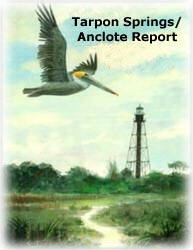
Tarpon Springs / Anclote River Report
12/28/03
Several poignant winter cold fronts cleared the state the past 3 weeks. We
enjoyed an extended fall season with above average water temperatures right into
December. As it typically happens in Florida, we then went from that right into
winter conditions. Water temperatures dropped into the middle 50’s, subsequently
sending near every species of fish inside the deep creeks, rivers, canals or
well offshore. It takes and has been a few weeks for the fish to acclimate to
the changes and develop a winter pattern.
Deep holes in the creeks and rivers are classic winter retreats for redfish.
While the fish are often not the bull reds we see schooled up on the flats
during more temperate conditions, once located, what they can offer is some
excellent winter fishing. For the most part the fish range from 15 to 25 inches.
The standard set up is a live shrimp rigged on a jig head just heavy enough to
reach the bottom of these holes, drop-offs, river bends and swashes. Mangrove
snapper, jack carvelle, ladyfish, snook, sheephead and the oddball tarpon will
be found in similar areas as well. The weighted live shrimp will act
nondiscriminatory and just as productive towards these species of fish as well.
Closer to the mouths of these areas, trout will find refuge on the cold evenings
and just after a passing front. Other areas to target winter trout are on the
flats adjacent to the Intercoastal, behind barrier islands and small spoil
islands. Fish your baits deep under cool conditions and shallow on the warming
trends. Winter trout will use the shallows to both forage and sun themselves in
the heat of the day. Tout like all species of Florida game fish become sluggish
during extreme winter conditions, artificial bait presentations should be just
as slow.
Our unique area features a fossil fuel power plant that serves as a warm water
spa for many species of fish, most notably pompano, permit, jacks and cobia.
Jigs tipped with a small piece of shrimp worked down the current edges get the
nod for success here. The fish will stay tight to the warm water outflow under
the coldest conditions. As a warming trend begins to develop, many of the fish
will venture outside the plant to forage on the flats. On Indian summer days and
depending on the tide strengths, the fish will “ride” the warm water several
miles away (in the direction of the flood or ebbing tide) and return to the
plant at dusk.
Pompano are notorious for following this warm water flow, particularly if peak
current flows coincide with the late and warm afternoon. Depending on the tide
direction, I will run the boat on plane across the flats being blanketed by the
warm water in an “s” pattern looking to “skip” pompano in the wake of my boat.
Once I locate the fish, I shut down and begin “fan casting” the area with small
yellow jigs that are most often associated with freshwater pan fishing. Pompano
are excellent table fair and require some finesse to catch them on hook and
line. For these reasons, they are one of my favorite species of challenge to
target.
Snook are hunkered down and in tight pods deep up the rivers and canals. Snook
are neo tropical fish that are not native to Florida. They are extremely
sensitive to cold water and sudden changes in the temperature. When the water
drops below 60 degrees they become very sluggish and sometimes stunned by the
cold. Below water temperatures in the mid 50s, the fish stressed beyond their
lashings of Jack Frost, they die. For this reason the state protects them from
harvest December 15 till February 1st. Years ago I participated in developing
techniques and finding/catching snook when they left the flats for winter.
Within our secret society of night snookers, we tuned and honed our skills to
near the point of perfection and guarantee. Today those same developments are
standard “theories” accepted by the new generation of snook anglers. With the
popularity the species gained the past decade and the fact that the fish are
easy targets when massed in deep holes, I decided for myself that it was best to
leave them alone and cut them some slack. For these reasons I no longer target
the species during the winter closure. I do still travel by truck, boat and foot
to these locations of yesteryear where I can see the fish “sunning” in the heat
of the day.
While the “glamour species” is not that compared the rest of the year-there is
plenty of action to found with decent temperatures and patience.
I want to take this occasion to thank all of you for making 2003 another
successful year for me. Over the years, many friendships have developed over the
traditional escape of fishing no matter how well or poor we did. Year after
year, I consider myself fortunate for the friendships, experiences, and
followings I have shared with many of you that have become family to me over the
years. I am truly grateful and blessed. Thank you!
Peace, Prosperity and All the Best in 2004!
Screaming Drags and Tired Arms!
Capt. Robert McCue
Bounty Hunter Sportfishing Guide Service
1(800) 833-0489 Toll Free USA ONLY
(727) 843-0489 Local and Universal
Visit Our Online
COLOR Brochure